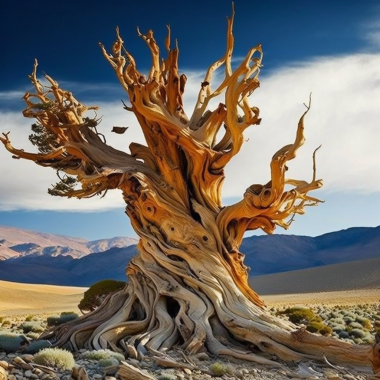
Introduction
The introduction provides a brief overview of the article and introduces the topic of the world's oldest surviving tree, which is a bristlecone pine located in California. The section also highlights the importance of the tree for science and history, given its remarkable age of over 5,000 years. The purpose of this section is to set the context for the article and provide a general idea of what readers can expect to learn from it.
The Bristlecone Pine
Physical description of the tree: The bristlecone pine (Pinus longaeva) is a coniferous tree that grows in the mountainous regions of the western United States, primarily in California, Nevada, and Utah. It typically reaches a height of 16 to 49 feet, with a diameter of 1 to 3 feet at its base. The tree has a distinctive appearance, with gnarled and twisted branches and needles that grow in clusters of five.
Natural habitat and distribution: Bristlecone pines are found at high elevations, typically between 5,600 and 11,200 feet above sea level. They grow in rocky, arid soils and are often found on exposed ridges and slopes. The trees have a relatively limited range, primarily occurring in the Great Basin region of the western United States.
Unique adaptations that allow for longevity: Bristlecone pines are known for their exceptional longevity, with some trees living for more than 5,000 years. They are able to survive in harsh, arid environments due to a number of unique adaptations, including a shallow root system that allows them to access water from the soil surface, a thick bark that protects them from fire and disease, and a slow growth rate that conserves resources. These adaptations have enabled the bristlecone pine to survive for millennia, making it one of the oldest living organisms on Earth.
History and Significance
The bristlecone pine was first discovered and recognized as the world's oldest tree in the 1950s by dendrochronologist Edmund Schulman. Schulman was studying tree rings in the White Mountains of eastern California when he came across a bristlecone pine that he estimated to be over 4,000 years old. Later research confirmed that the bristlecone pine species can live for over 5,000 years, making it the oldest known living organism on the planet.
Bristlecone pines have been used extensively in climate and environmental research due to their incredibly long lifespans. By studying the growth rings of the trees, scientists can gain insight into past climate patterns, including temperature and precipitation. Bristlecone pines have also been used to study the effects of air pollution and other environmental factors on tree growth.
The bristlecone pine has significant cultural and spiritual importance to several indigenous peoples of the region, including the Paiute and Shoshone tribes. The trees have been used for medicinal purposes, as well as for making baskets, bowls, and other tools. Many indigenous communities continue to protect and care for the trees as part of their cultural heritage.
Threats to the Bristlecone Pine
A. Human impact on the environment
- Logging and development
- Air pollution
- Invasive species
B. Climate change and its effects on the tree
- Increased temperatures
- Changes in precipitation patterns
- Extreme weather events
C. Efforts to protect and preserve the tree and its habitat
- National parks and protected areas
- Conservation and restoration projects
- Public education and awareness campaigns
The Bristlecone Pine, despite its incredible longevity and resilience, is not immune to the threats facing many other species on Earth. Human impact on the environment, including logging and development, air pollution, and the introduction of invasive species, have all had negative effects on the Bristlecone Pine and its habitat. Additionally, climate change is expected to have a significant impact on the tree, as increased temperatures and changes in precipitation patterns can alter the delicate balance of conditions that allow the tree to thrive.
However, there are efforts underway to protect and preserve the Bristlecone Pine and its habitat. National parks and protected areas have been established to conserve the tree, and conservation and restoration projects are working to address the threats facing the tree. Public education and awareness campaigns are also important in ensuring that people understand the significance of the Bristlecone Pine and the importance of protecting it for future generations.
Conclusion
the bristlecone pine is the world's oldest surviving tree, with some specimens living for over 5,000 years. This tree has unique adaptations that allow it to survive in harsh environments and has played an important role in climate and environmental research. Additionally, the bristlecone pine has cultural significance to indigenous peoples of the region. However, this ancient tree faces threats from human impact on the environment and climate change. It is important to protect and preserve the bristlecone pine and other natural wonders for future generations to appreciate and study.
